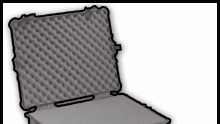The shooter's double threat

It's a jungle out there. Lurking everywhere are slick stair steps, sudden thunderstorms, baggage handlers having a bad day and cables snaking their way around light stands, just waiting to bring down your setup like a house of cards. But you don't have to tread into this wilderness unprotected.
The two most common natural enemies of shooters and their gear are impacts and water. They will strike when you least expect it, so it's best to always be protected against this double threat.
The most versatile equipment cases have pre-cut dice foam squares that allow you to create virtually any shape of padded cut-out inside the case. Case photo courtesy of Pelican. Lens photo courtesy of Thales Angenieux.
While impacts do happen during camera- and sound-gear operation, particularly in ENG environments, the most frequent impact damage occurs during transport. The best protection involves forsaking makeshift solutions and getting tailor-made cases for each piece of equipment. Fortunately, there are road cases and rain gear available for a wide variety of makes and models of cameras, sound mixers, light stands, computers and rack-mount items. Most serve the same dual purpose of protecting the equipment and helping shooters keep track of the dozens of little widgets essential to well-equipped ENG/EFP crews.
Every professional video camera purchase should include a case with foam padding cut to precisely fit the camera shape. A problem here is that any accessories such as mounts, grips and other semi-permanent attachments can ruin the fit. The flexibility of dice foam can solve this problem. The foam is pre-cut into small squares so that you can remove one or more squares to create virtually any shape of padded cut-out inside the case. When you add new attachments to the camera or mixer, simply add or remove a few dice foam squares to maintain the snug fit required for maximum jolt protection.
While the case interior must be soft and pliable, the exterior has to be tough. Aluminum cases come in all sizes and most have rounded, reinforced corners and locks. The larger cases, particularly those with rollers for heavier items, will get the worst banging around and scraping against other surfaces. This repeated action tends to knock off protruding fittings, so, with the larger cases, it is best to go with recessed handles, latches and jack dishes. High-level audio-monitoring equipment like that typically used on music video shoots can benefit from metallic speaker-grille covers to prevent tripod legs and other marauders from spearing your cones.
When you are toting your own gear, flexible canvas bags can save weight and time. Many of them also allow you to operate the equipment through the bag. This prevents water damage, dirty sound-mixing pots and scratched meter faces. You can fold nylon bags for tripods and light stands and store them in small spaces at the shoot. For shipping, when others will be doing the lugging for you, more rigid enclosures such as tripod tubes and molded cases are best. Look for equipment that conforms to the Air Transport Association specification 300, Category One standard for re-useable shipping containers.
Get the TV Tech Newsletter
The professional video industry's #1 source for news, trends and product and tech information. Sign up below.
For outdoor events, it’s always a good idea to have rain protection for the camera as well as for yourself. Photo courtesy of Jim Boston.
Some EFP mixer cases allow you to operate them in a driving rainstorm. Each is made of rip-stop nylon, has a set of sleeves for the operator and bears a clear plastic window over the mixer controls. This type of cover should have a DWR (water-resistance) rating of at least 80 on a scale of 100. For cameras, storm coats are available with just the right openings for cables and attachments on specific camera models and perfect access to viewfinder and controls.
Getting organized
Another large challenge for field shooters is keeping up with the army of small gadgets they frequently need. Many of the canvas bags and carrying cases currently available include an array of pockets, elastic straps and Velcro patches for holding gaffer's tape, pens, tie wraps and other tools. One of the most popular carrier items is the video vest. This waterproof vest has compartments for every type of tool and accessory the field shooter needs, and it looks sporty, too.
Another useful nylon item is the Straddlebag for wireless-mic receivers. With this, you can sling any type of receiver across the brick bats on the rear of an EFP camera while keeping the antennas completely unobstructed.
For those situations where the shooter will want to share the same protected environment as the camera, there is the rain cape that has a flexible plastic bubble top with enough room so that the shooter and the shoulder-mounted camera can operate in what is essentially a walking tent. Soundman ponchos provide the same environment and use a transparent front so you can see and operate the chest-worn mixer. Rounding out the shooter's wish list are fingerless gloves that provide protection and allow you to operate tiny controls.
The endless array of specially designed rain gear and cases gives today's ENG/EFP crews a formidable defense against the relentless challenges of impacts and water.
Bennett Liles is a writer and TV production engineer in the Atlanta area.
